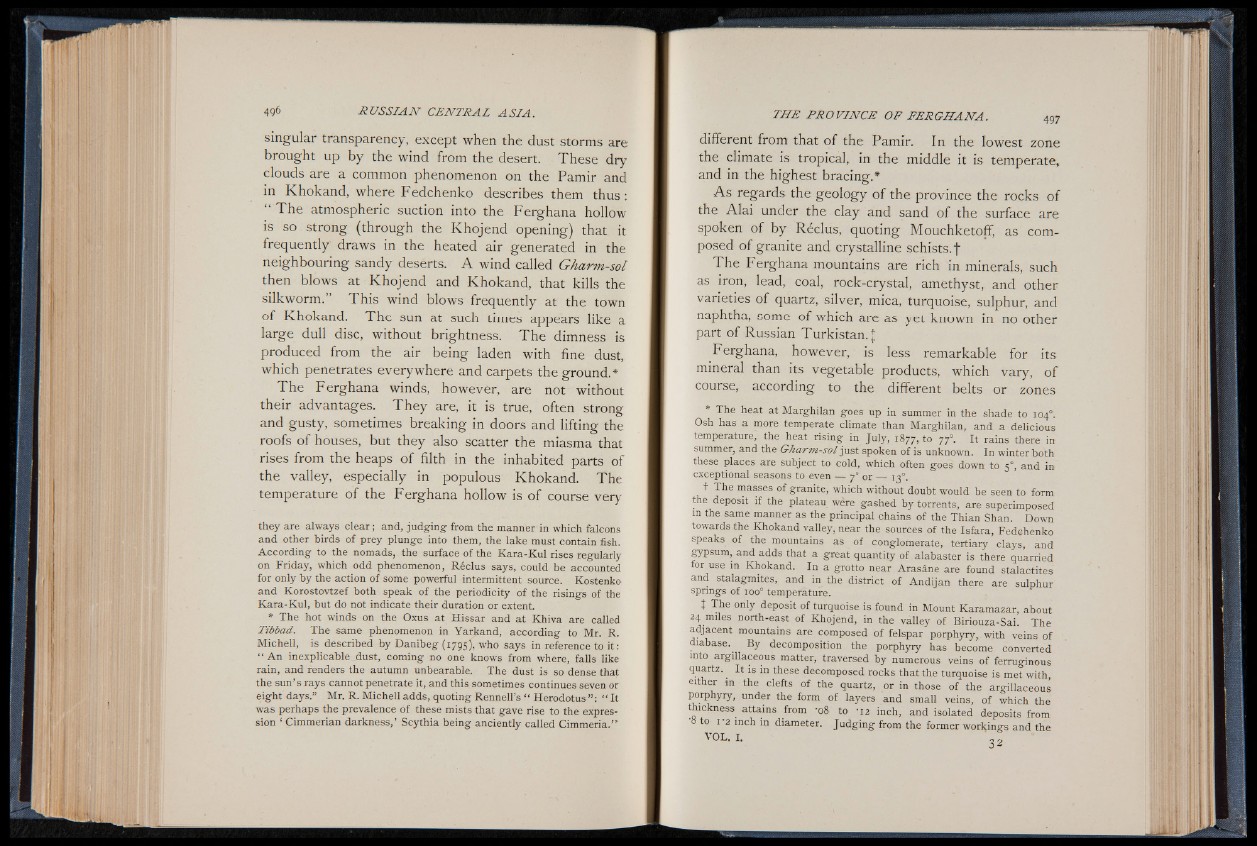
singular transparency, except when the dust storms are
brought up by the wind from the desert. These dry
clouds are a common phenomenon on the Pamir and
in Khokand, where Fedchenko describes them thus:
“ The atmospheric suction into the Ferghana hollow
is so strong (through the Khojend opening) that it
frequently draws in the heated air generated in the
neighbouring sandy deserts. A wind called Gharm-sol
then blows at Khojend and Khokand, that kills the
silkworm.” This wind blows frequently at the town
of Khokand. The sun at such times appears like a
large dull disc, without brightness. The dimness is
produced from the air being laden with fine dust,
which penetrates everywhere and carpets the ground.*
The Ferghana winds, however, are not without
their advantages. They are, it is true, often strong
and gusty, sometimes breaking in doors and lifting the
roofs of houses, but they also scatter the miasma that
rises from the heaps of filth in the inhabited parts of
the valley, especially in populous Khokand. The
temperature of the Ferghana hollow is of course very
they are always clear; and, judg ing from the manner in which falcons
and other birds of prey plunge into them, the lake must contain fish.
According to the nomads, the surface of the Kara-Kul rises regularly
on Friday, which odd phenomenon, Réclus says, could be accounted
for only by the action of some powerful intermittent source. Kostenko
and Korostovtzef both speak of the periodicity of the risings of the
Kara-Kul, but do not indicate their duration or extent.
* The hot winds oii the Oxus at Hissar and at Khiva are called
Tibbad. The same phenomenon in Yarkand, according to Mr. R.
Michell, is described by Danibeg (1795), who says in reference to it:
“ An inexplicable dust, coming no one knows from where, falls like
rain, and renders the autumn unbearable. The dust is so dense that
the sun’ s rays cannot penetrate it, and this sometimes continues seven or
eight days.” Mr. R. Michell adds, quoting Rennell’s “ Herodotus “ It
was perhaps the prevalence of these mists that gave rise to the expression
‘ Cimmerian darkness,’ Scythia being anciently called Cimmeria.”
different from that of the Pamir. In the lowest zone
the climate is tropical,, in the middle it is temperate,
and in the highest bracing.*
A s regards the geology of the province the rocks of
the Alai under the clay and sand of the surface are
spoken of by Rdclus, quoting Mouchketoff, as composed
of granite and crystalline schists, f
The Ferghana mountains are rich in minerals, such
as iron, lead, coal, rock-crystal, amethyst, and other
varieties of quartz, silver, mica, turquoise, sulphur, and
naphtha, some of which are as yet known in no other
part of Russian Turkistan. J
Ferghana, however, is less remarkable for its
mineral than its vegetable products, which vary, of
course, according to the different belts or zones
* The heat at Marghilan goes up in summer in the shade to 104°.
Osh has a more temperate climate than Marghilan, and a delicious
temperature, the heat rising in July, 1877, to 77°. It rains there in
summer, and the Gharm-sol just spoken of is unknown. In winter both
these places are subject to cold, which often goes down to 5°, and in
exceptional seasons to even — 7° o r 13°.
t The masses of granite, which without doubt would be seen to form
the deposit if the plateau were gashed by torrents, are superimposed
m the same manner as the principal chains of the Thian Shan. Down
towards the Khokand valley, near the sources of the Isfara, Fedehenko
speaks of the mountains as of conglomerate, tertiary clays, and
gypsum, and adds that a great quantity of alabaster is there quarried
for use in Khokand. In a grotto near Arasane are found stalactites
and stalagmites, and in the district of Andijan there are sulphur
springs of ioo° temperature.
% The only deposit of turquoise is found in Mount Karamazar, about
24 miles north-east of Khojend, in the valley of Biriouza-Sai. The
adjacent mountains are composed of felspar porphyry, with veins of
labase. By decomposition the porphyry has become converted
into argillaceous matter, traversed by numerous veins of ferruginous
quartz. It is in these decomposed rocks that the turquoise is met with,
either m the clefts of the quartz, or in those of the argillaceous
porphyry, under the form of layers and small veins, of which the
thickness attains from -08 to -12 inch, and isolated deposits from
0 to 1-2 inch in diameter. Judging from the former workings and the
VOL. I. 3 2 '